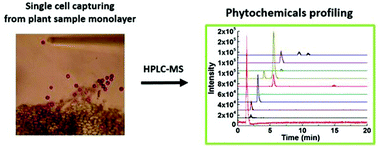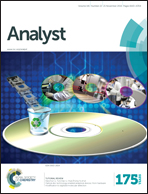Phytochemical profiling in single plant cell by high performance liquid chromatography-mass spectrometry†
Abstract
Phytochemicals are essential secondary plant metabolites which play important roles in the areas of plant biochemistry, pharmacy and medical science because of their significant bioactivities. Conventional analysis of phytochemicals in plants needs a complex combination of different extraction and separation steps. Here a simple and universal method for profiling phytochemicals in a single plant cell was demonstrated based on high performance liquid chromatography-mass spectrometry. Single purple and colorless cell samples (about 15 μm in size) found in the outer layer of a young stem of Forsythia suspensa, just inside the cuticles were collected and transferred by glass micropipettes from cell monolayers. At least 30 peaks were separated and detected, and 24 of these peaks were identified. Apart from several common plant metabolites in high abundance, like polysaccharides and amino acids, 9 phytochemicals that have special bioactivities in this plant and in medical treatment were successfully detected. Phytochemical differences between these two kinds of cells were also distinguished which was applied to investigate the heterogeneity of cells from different parts of plants and the dependency of important plant bioprocesses on phytochemical changes.



 Please wait while we load your content...
Please wait while we load your content...